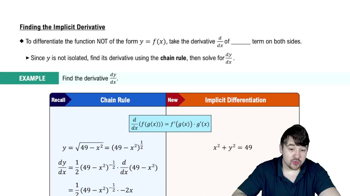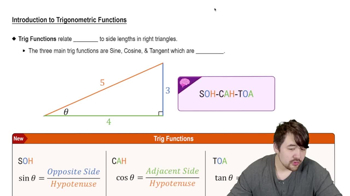Table of contents
- 0. Functions7h 52m
- Introduction to Functions16m
- Piecewise Functions10m
- Properties of Functions9m
- Common Functions1h 8m
- Transformations5m
- Combining Functions27m
- Exponent rules32m
- Exponential Functions28m
- Logarithmic Functions24m
- Properties of Logarithms34m
- Exponential & Logarithmic Equations35m
- Introduction to Trigonometric Functions38m
- Graphs of Trigonometric Functions44m
- Trigonometric Identities47m
- Inverse Trigonometric Functions48m
- 1. Limits and Continuity2h 2m
- 2. Intro to Derivatives1h 33m
- 3. Techniques of Differentiation3h 18m
- 4. Applications of Derivatives2h 38m
- 5. Graphical Applications of Derivatives6h 2m
- 6. Derivatives of Inverse, Exponential, & Logarithmic Functions2h 37m
- 7. Antiderivatives & Indefinite Integrals1h 26m
- 8. Definite Integrals4h 44m
- 9. Graphical Applications of Integrals2h 27m
- 10. Physics Applications of Integrals 2h 22m
4. Applications of Derivatives
Implicit Differentiation
Problem 3.8.27
Textbook Question
27–40. Implicit differentiation Use implicit differentiation to find dy/dx.
sin x+sin y=y
 Verified step by step guidance
Verified step by step guidance1
Start by differentiating both sides of the equation with respect to x. The equation is sin(x) + sin(y) = y.
Differentiate sin(x) with respect to x, which gives cos(x).
Differentiate sin(y) with respect to x. Since y is a function of x, use the chain rule: the derivative is cos(y) * (dy/dx).
Differentiate y with respect to x, which is simply dy/dx.
Combine all the differentiated parts: cos(x) + cos(y) * (dy/dx) = dy/dx. Solve this equation for dy/dx to find the derivative.
 Verified video answer for a similar problem:
Verified video answer for a similar problem:This video solution was recommended by our tutors as helpful for the problem above
Video duration:
3mPlay a video:
Was this helpful?
Key Concepts
Here are the essential concepts you must grasp in order to answer the question correctly.
Implicit Differentiation
Implicit differentiation is a technique used to differentiate equations where the dependent and independent variables are not explicitly separated. Instead of solving for one variable in terms of the other, we differentiate both sides of the equation with respect to the independent variable, applying the chain rule when necessary. This method is particularly useful for equations involving both x and y, allowing us to find the derivative of y with respect to x.
Recommended video:

Finding The Implicit Derivative
Chain Rule
The chain rule is a fundamental principle in calculus that allows us to differentiate composite functions. It states that if a function y is defined as a function of u, which in turn is a function of x, then the derivative of y with respect to x can be found by multiplying the derivative of y with respect to u by the derivative of u with respect to x. This rule is essential in implicit differentiation, especially when differentiating terms involving y.
Recommended video:

Intro to the Chain Rule
Trigonometric Functions
Trigonometric functions, such as sine and cosine, are fundamental functions in calculus that relate angles to ratios of sides in right triangles. In the context of the given equation, sin x and sin y represent the sine of the angles x and y, respectively. Understanding the properties and derivatives of these functions is crucial for applying implicit differentiation, as their derivatives (e.g., the derivative of sin y is cos y dy/dx) will be used in the differentiation process.
Recommended video:

Introduction to Trigonometric Functions

 5:14m
5:14mWatch next
Master Finding The Implicit Derivative with a bite sized video explanation from Nick
Start learningRelated Videos
Related Practice


